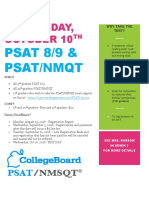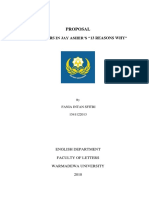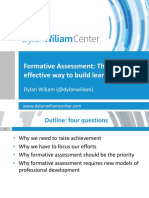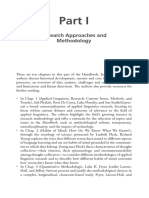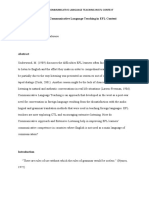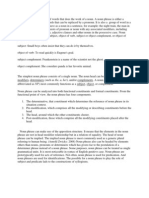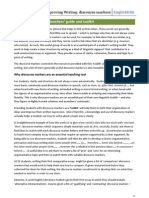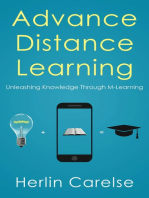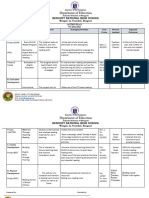Homophone Reading Lesson PDF
Homophone Reading Lesson PDF
Uploaded by
api-239228406Copyright:
Available Formats
Homophone Reading Lesson PDF
Homophone Reading Lesson PDF
Uploaded by
api-239228406Original Title
Copyright
Available Formats
Share this document
Did you find this document useful?
Is this content inappropriate?
Copyright:
Available Formats
Homophone Reading Lesson PDF
Homophone Reading Lesson PDF
Uploaded by
api-239228406Copyright:
Available Formats
Bridgewater
College
Education Department Lesson Plan Date: November 10, 2012 Subject Area(s): Reading VA SOL
Name: Rosie Ehlers
Title
of
Lesson:
Homophone
Fun
Grade
Level(s):
2
Reading
2.7
The
student
will
expand
vocabulary
when
reading.
a.
use
knowledge
of
homophones
Oral
Language
2.2
The
student
will
expand
understanding
and
use
of
word
meanings.
a.
increase
listening
and
speaking
vocabularies.
nd
Content Objective(s) At the conclusion of the lesson, the student will be able to identify at least 11 homophone pairs. These will include pairs from the story Dear Deer and pairs that we come up with as a class. The student will also be able to correctly determine which homonym should be used in a sentence when given the choice between the following pairs: see and sea, blew and blue, rose and rows, be and bee, piece and peace, one and won. IEP Goal/Objective: Accommodations/ Differentiation Summative Assessment (based on objectives) A small version of formative assessment will occur at the conclusion of the lesson. Through the Pair of Pears activity and the Homophone worksheet, the teacher will be able to determine how well the students have grasped the concept of homophone pairs. Summative assessment will occur at the conclusion of the reading unit. -To assess the students knowledge of homophones, there will be a section on the test that will involve identifying homophone pairs. -This section will have two parts. In the first part, students will draw lines to match homophone pairs from two separate columns. In the second part, students will look at pictures that illustrate different homophone pairs, and they will write the correct word under each picture to identify the pair. Materials Storybook Dear Deer (AR level 2.1) 5 sets of homophone pairs that will be seen in the book Dear Deer. These will be ClipArt pictures of each pair, glued onto construction paper. (These sets include moose and mousse, doe and dough, blue and blew, read and red, and pause and paws) Copies of the brainstorm chart (enough for each student and a teacher copy) Copies of the Pair of Pears worksheet (enough for each student and a teacher copy) Copies of the Homophones worksheet (enough for each student and a teacher copy) Copies of frogs (two copies of frog sheet for each student and a teacher copy) Sheets of green construction paper (enough for each student) A completed Pair of Pears to model for students A completed set of frogs glued to construction paper to model for students
Integration of technology N/A
Anticipatory Set (Focus) Good morning students! Today during reading we will be learning about homophones. We see homophones in written text and spoken language on a daily basis. Learning to recognize homophone pairs is a very important part of becoming successful at reading and writing. With the help of Aunt Ant and Dear Deer, you will be a homophone professional in no time! Access/Review Prior Knowledge In order to access and review prior knowledge, I will pull some word pairs to go over before starting the topic presentation. These are words that students will recognize because they will have used them on a regular basis. At the start of the lesson, students will gather on the classroom rug and circle around me. This will ensure that all students can see the picture examples. These will include the pairs listed under the materials section. For instance, I will show the students the pair blew and blue. Based on the pictures and their understanding of the words, students will practice saying each word with me. Topic presentation (What will the students be told?) (Students will still be seated on the rug for the topic presentation and the reading of the story). Homophones are words that have the same pronunciation but have different meanings and different spellings. It is important that we know the difference between homophones by using context clues while reading. In order to understand the differences between homophones we must practice our knowledge of them. Throughout this lesson we will pay attention to the context clues and learn how to correctly write and understand homophones. We can find homophones in all different types of reading and writing. The picture pairs we looked at earlier each represent a homophone pair because the words sound the same but have different meanings and spellings. Today we are going to read a story called Dear Deer. This book is full of homophone pairs. Aunt Ant and Dear Deer are going to help us achieve our goal of becoming homophone experts. I am going to read the story aloud to you. At the conclusion of each page, we will point out homophone pairs and go over the meanings of each word. If you have any questions as I read, please feel free to ask. Also, try to remember some of the pairs from the story. At the end of the story, we will need to remember the homophone pairs for our brainstorming activity. -Read through the story with students, making sure to use the pointing technique to help students follow along. The homophone pairs are in bold, so this technique will be very beneficial. Pay close attention when reading words such as ewe, mousse, and gnus, because students might not be sure of their meanings.
Accommodations/ Differentiation
Time Planned 1 minute
8 minutes
20 minute s
Modeling, Guided Practice, Independent Practice, Checking for Understanding (Formative Assessment) (At the conclusion of the story, students will return to their desks). Now that we have learned many homophone pairs from Aunt Ant and Dear Deer, we are going to brainstorm and write these pairs on our chart. -Each student will be given a copy of the brainstorm chart (attached). I will create a similar chart on the chalkboard for students to refer to if they have any questions about spelling. We are going to go around the room and each try to name off and explain a homophone pair that we remember from the story. If you would like, you can also list other homophone pairs that were not in the story. -If students cannot think of a pair, they can phone a friend for help. -If students seem to not understand a specific pair, we will draw pictures by each word to illustrate the difference between the homophones. Now, we are going to create a Pair of Pears (attached). Each of you will create two pairs. From the brainstorming sheet, you will choose two homophone pairs. On the front of the pears, you will write the words of the homophone pairs. On the front you may also draw a small picture to illustrate the difference between the two words. Next, you will write a sentence using each word on the back of each pear. Once you have finished labeling your pears and writing your sentences, you may color the front of the pears. Once you finish your pears, you will complete the Homophone worksheet (attached). There are 5 sentences on the worksheet with two choices of homophones to put in the blanks. You will need to choose the correct homophone to use for each sentence. If you finish your worksheet early, I will give you 2 sheets of 4 frogs (attached). You can think of 4 more homophone pairs and cut out the frogs, and then glue them on to a sheet of green construction paper. -During this independent practice, I will walk around the room to check for understanding and offer help to struggling students. Closure Today we learned a very important skill that will help us in our future reading and writing activities. Homophones are words that sound the same, but they have different spellings and meanings. We learned how to pick out homophones and how it is important to use context clues to determine the meaning of a word. With the help of Aunt Ant and Dear Deer, we are all homophone professionals!
30 min utes
1 minute
You might also like
- Psat FlyerDocument2 pagesPsat Flyerapi-260853196No ratings yet
- LIDDICOAT - Five Principles of Intercultural Language LearningDocument2 pagesLIDDICOAT - Five Principles of Intercultural Language LearningBeatriz Peña Dix100% (1)
- Chapter 9, "Organizing The Body of The Speech"Document1 pageChapter 9, "Organizing The Body of The Speech"Shireen YakubNo ratings yet
- Glossary of Literacy Terms: AbbreviationDocument11 pagesGlossary of Literacy Terms: Abbreviationالتداوي بالاعشاب الطبية ببراقيNo ratings yet
- Cooperative Learning Methods: A Meta-AnalysisDocument6 pagesCooperative Learning Methods: A Meta-AnalysisSatria CemenNo ratings yet
- Proposal: Metaphors in Jay Asher'S "13 Reasons Why"Document27 pagesProposal: Metaphors in Jay Asher'S "13 Reasons Why"Fania IntanNo ratings yet
- Quiz 2 AnswerDocument9 pagesQuiz 2 AnswerFelix Llamera50% (4)
- Conjunctive Adverb WorksheetsDocument3 pagesConjunctive Adverb WorksheetsrichschnoorNo ratings yet
- The Very Hungry Caterpillar Lesson PlanDocument3 pagesThe Very Hungry Caterpillar Lesson Planapi-291353197No ratings yet
- The Home School Connection: Family Page Project Baby Name ProjectDocument10 pagesThe Home School Connection: Family Page Project Baby Name ProjectRegimae PepitoNo ratings yet
- Wiliams Workshop Formative AssessmentDocument33 pagesWiliams Workshop Formative Assessmentprebolledoc100% (1)
- Navigating SeesawDocument14 pagesNavigating Seesawapi-488522949100% (1)
- Challenges in Teaching Pronunciation at Tertiary Level in BangladeshDocument12 pagesChallenges in Teaching Pronunciation at Tertiary Level in BangladeshIJ-ELTSNo ratings yet
- Steps of Translating TextDocument12 pagesSteps of Translating TextQoriNo ratings yet
- SemanticsDocument50 pagesSemanticsHazirah MustapaNo ratings yet
- Introduction Authentic MaterialsDocument3 pagesIntroduction Authentic MaterialsIoana MariaNo ratings yet
- Translation Thesis ReportDocument7 pagesTranslation Thesis ReportRafika FairuzNo ratings yet
- Sociolinguistics On AccentsDocument15 pagesSociolinguistics On AccentsrazielkaNo ratings yet
- Why Listening To Music Is The Key To Good HealthDocument2 pagesWhy Listening To Music Is The Key To Good HealthDianaNo ratings yet
- Journal-Translation (Microsoft 2003)Document14 pagesJournal-Translation (Microsoft 2003)artiNo ratings yet
- The University of Education, HCMC English Language Teaching Methodology 2 Department of EnglishDocument6 pagesThe University of Education, HCMC English Language Teaching Methodology 2 Department of EnglishLily ChangNo ratings yet
- Developing Listening Skills With Authentic MaterialsDocument13 pagesDeveloping Listening Skills With Authentic MaterialsCamille IcasianoNo ratings yet
- Contrastive Functional Analysis, Andrew ChestermanDocument19 pagesContrastive Functional Analysis, Andrew ChestermanXeniaNo ratings yet
- Applied Linguistics Research MethodologyDocument6 pagesApplied Linguistics Research MethodologyafsaneNo ratings yet
- Assessing ListeningDocument5 pagesAssessing ListeningVinnieNo ratings yet
- Extensive Listening in CLT in EFL ContextDocument9 pagesExtensive Listening in CLT in EFL ContextAbir BotesNo ratings yet
- The Nature of Listening SkillsDocument12 pagesThe Nature of Listening SkillsIlham IsmailNo ratings yet
- Ielts FinalDocument15 pagesIelts Finalmehenazmul566No ratings yet
- Materials For Developing Writing Skills: Sarah O. CruzDocument17 pagesMaterials For Developing Writing Skills: Sarah O. CruzLovely Karen PaguioNo ratings yet
- Ma1 Socio Assignment PDFDocument5 pagesMa1 Socio Assignment PDFImed LarrousNo ratings yet
- Turn Taking Discourse AnalysisDocument6 pagesTurn Taking Discourse AnalysisDevi CahyaniNo ratings yet
- 100 Ways To Seesaw - FlashcardsDocument26 pages100 Ways To Seesaw - Flashcardsapi-330205984No ratings yet
- Group 3 Semantic PragmaticDocument20 pagesGroup 3 Semantic PragmaticChaken SamangunNo ratings yet
- UNIT 7:then and Now: II. DemandsDocument6 pagesUNIT 7:then and Now: II. DemandsLuu FlyNo ratings yet
- History of Language TeachingDocument14 pagesHistory of Language TeachingRia RarasatiNo ratings yet
- Module 3 PDFDocument10 pagesModule 3 PDFFreud Bnjie Cblit DoleraNo ratings yet
- Limitations of English Teaching in ChinaDocument2 pagesLimitations of English Teaching in ChinaNur AtikahNo ratings yet
- Formative AssessmentDocument20 pagesFormative AssessmentDiksha UttamNo ratings yet
- The Teacher-Student Communication Pattern: A Need To Follow?Document7 pagesThe Teacher-Student Communication Pattern: A Need To Follow?Alexandra RenteaNo ratings yet
- Compare and Contrast Between First and Second Language AcquisitionDocument1 pageCompare and Contrast Between First and Second Language AcquisitionBarbara Wendy JunaNo ratings yet
- A Noun PhraseDocument7 pagesA Noun Phrasescribder994realNo ratings yet
- Effects On Reading Comprehension of Building Background Knowledge. 1982 PDFDocument15 pagesEffects On Reading Comprehension of Building Background Knowledge. 1982 PDFpapeleritoNo ratings yet
- Minimalism and ExplanationDocument9 pagesMinimalism and Explanationbugarin487No ratings yet
- Anthology Review Pedagogical GrammarDocument17 pagesAnthology Review Pedagogical Grammarapi-201107267No ratings yet
- Verb ComplementationDocument19 pagesVerb ComplementationLourdes Virginia100% (1)
- Audio Lingual MethodDocument12 pagesAudio Lingual MethodKeviin Mariño VivasNo ratings yet
- Intensive and Extensive ListeningDocument18 pagesIntensive and Extensive ListeningMaria Octa ElsavanaNo ratings yet
- 1.1. A Sequence of Critical Thinking Tasks JOHN BEAUMONTDocument22 pages1.1. A Sequence of Critical Thinking Tasks JOHN BEAUMONTdanigheoNo ratings yet
- Intro To Sociolings 6 Final ReviewDocument65 pagesIntro To Sociolings 6 Final ReviewNel SweetieNo ratings yet
- Sociolinguistic AssignmentDocument11 pagesSociolinguistic AssignmentRiska Alfin Pramita100% (1)
- Authentic Materials in Extensive Reading ClassDocument19 pagesAuthentic Materials in Extensive Reading Classadhyl100% (2)
- Шпаргалка по грамматике английского языкаDocument11 pagesШпаргалка по грамматике английского языкаDasha Vafina100% (1)
- PDFDocument337 pagesPDFSolihinNaimNo ratings yet
- Compliments and Compliment Responses in Kunming ChineseDocument7 pagesCompliments and Compliment Responses in Kunming ChineseKatrina NacarNo ratings yet
- Types of Tests Used in English Language Teaching Bachelor PaperDocument41 pagesTypes of Tests Used in English Language Teaching Bachelor Papermahendrats100% (3)
- Contrastive Analysis (CA)Document2 pagesContrastive Analysis (CA)Amira BenredjemNo ratings yet
- The Effect of PQRST Method On The StudentDocument30 pagesThe Effect of PQRST Method On The StudentMuhammad Hidayatul RifqiNo ratings yet
- Discourse Markers ToolkitDocument8 pagesDiscourse Markers ToolkitJoyce TeeTaNo ratings yet
- Desuggestopedia - Research PaperDocument15 pagesDesuggestopedia - Research PaperUsama MaherNo ratings yet
- Differences Between First Language Acquisition and Second Language LearningDocument2 pagesDifferences Between First Language Acquisition and Second Language LearningMahaletchumy SubramaniamNo ratings yet
- Discourse AnalysisDocument33 pagesDiscourse Analysismuine15No ratings yet
- Optimality Theory: Presented by Ashour Abdulaziz, Eric Dodson, Jessica Hanson, and Teresa LiDocument32 pagesOptimality Theory: Presented by Ashour Abdulaziz, Eric Dodson, Jessica Hanson, and Teresa LiMiguelZepedatorNo ratings yet
- Research Methods in Sign Language Studies: A Practical GuideFrom EverandResearch Methods in Sign Language Studies: A Practical GuideRating: 3 out of 5 stars3/5 (1)
- Performance AppraisalDocument7 pagesPerformance Appraisalsrijubasu1121No ratings yet
- The Zone of Proximal Development and Scaffolding: ZPD ExampleDocument5 pagesThe Zone of Proximal Development and Scaffolding: ZPD ExampleJABP18No ratings yet
- Action Plan English ReadingDocument3 pagesAction Plan English ReadingRefenej TioNo ratings yet
- Brainard Cole ResumeDocument2 pagesBrainard Cole Resumeapi-567148854No ratings yet
- DLL - Science 6 - Q1 - W4Document3 pagesDLL - Science 6 - Q1 - W4Geoffrey Tolentino-UnidaNo ratings yet
- Literacy Across CurriculumDocument3 pagesLiteracy Across CurriculumAubrey AbuanNo ratings yet
- Digital Moc Product InfoDocument5 pagesDigital Moc Product InfoCristiano OrlandiNo ratings yet
- Evaluatorpineda Ocampoenric Demo-Teaching-Rubric FormDocument2 pagesEvaluatorpineda Ocampoenric Demo-Teaching-Rubric Formapi-711996372No ratings yet
- Cole Chaney ResumeDocument1 pageCole Chaney Resumeapi-349545594No ratings yet
- Supporting An Effective Learning Environment 5-28-19Document2 pagesSupporting An Effective Learning Environment 5-28-19Mary KidwellNo ratings yet
- BA 357 ECampus SyllabusDocument6 pagesBA 357 ECampus SyllabusYuna Ika DewiNo ratings yet
- CHN1 Course Outline 20 - 21Document14 pagesCHN1 Course Outline 20 - 21Edna Uneta RoblesNo ratings yet
- Chapter 7Document19 pagesChapter 7Leonardo LangaroNo ratings yet
- Sociological Foundations of Music EducationDocument18 pagesSociological Foundations of Music EducationJammer Aqua100% (1)
- Learner Centered InstructionDocument17 pagesLearner Centered InstructiongetondwnNo ratings yet
- Learning Episode 11Document18 pagesLearning Episode 11Melvin SumalinogNo ratings yet
- Concept Note - Conflict Transformation and Peace BuildingDocument4 pagesConcept Note - Conflict Transformation and Peace BuildingSubhankar ChakrabortyNo ratings yet
- Kimj Pe5 Acei 1Document3 pagesKimj Pe5 Acei 1api-243032126No ratings yet
- Yr 8 Re Lesson 2Document6 pagesYr 8 Re Lesson 2api-285939843No ratings yet
- Coursework Submission Sheet: Uk Transfer Programme (Law) : : 1 2:: KL PJDocument3 pagesCoursework Submission Sheet: Uk Transfer Programme (Law) : : 1 2:: KL PJAmardev SinghNo ratings yet
- Where Theres A Will Theres An A AnswersDocument9 pagesWhere Theres A Will Theres An A Answerssundevil2010usa4605No ratings yet
- Facilitator Training: Adult & Facilitated LearningDocument16 pagesFacilitator Training: Adult & Facilitated LearningRajendra LamsalNo ratings yet
- Indian Law Report - Allahabad Series - Apr2009Document76 pagesIndian Law Report - Allahabad Series - Apr2009PrasadNo ratings yet
- Fossil LessonDocument3 pagesFossil Lessonapi-328881062No ratings yet
- Wjiii Final PresentationDocument40 pagesWjiii Final Presentationapi-289842236100% (1)
- Revisiting - VMG & CV (2020)Document17 pagesRevisiting - VMG & CV (2020)Rhyme CabangbangNo ratings yet
